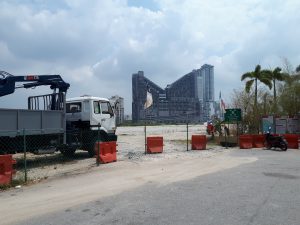The Malaysian state of Melaka has torpedoed a $10.5 billion Chinese-backed harbor development project after three years of inaction, likely spelling an end to the controversial enterprise.
In a statement this week, the Melaka Chief Minister’s Office said that it had canceled the agreement with KAJ Development, the local developer of the gargantuan Melaka Gateway development, which envisioned the construction of three artificial islands in the Malacca Strait.
The developers of the 246-hectare project envisioned the construction of economic zones, hotels, luxury housing, and various tourist attractions. The project, according to one article, “was to have a glittering business district, a robust marina, a giant ‘Malaysia Eye’ Ferris wheel, the largest cruise ship terminal in Southeast Asia, and a seven-star hotel.” All this was to be organized around a huge deepwater port.
In October 2017, KAJ Development signed an agreement to construct the project as a joint venture with PowerChina International, a major state-owned Chinese utility, and two Chinese port developers. According to the state government of Melaka, the agreement for the Melaka Gateway development expired on October 3, and a notice of termination was sent to the company on November 16. “The company is also required to return the project site, effective upon the termination notice issued by the state government,” it stated.
The Melaka Gateway project was first announced by then Prime Minister Najib Razak in 2014, shortly after a visit to Beijing. The company has since claimed the mantle of Beijing’s headline Belt and Road Initiative (BRI), though it remains unclear the extent to which the Chinese government recognized it as an “official” BRI project. According to the project’s website, “The strategic masterplan of Melaka Gateway’s development aligns with the principles of [BRI] as strategized by China.” The BRI, it opined, was set to “shower abundant trade opportunities and development on Malaysia’s ports, railways, and airports.”
Melaka Gateway was just one of several gargantuan Chinese investment deals signed by Najib’s government, which also included a large industrial zone and port refurbishment in Kuantan (Najib’s home state) and the mammoth $16.1 billion East Coast Rail Link, designed to bisect the Malayan peninsula.
From its inception, Melaka Gateway met with widespread skepticism. I happened to be in Malaysia in October 2017, when the agreement for the development was signed, and informed observers that I spoke to questioned whether Malaysia needed a new deepwater port, given the proximity of the facilities at Port Klang.
Others pointed out that KAJ had little experience in such large-scale construction projects, and was instead best known for building the city’s zoo and bird park, among other modest local developments. In a 2018 article, the New York Times cited locals who remarked on the close ties between the head of KAJ Development and the party machine of Najib’s United Malays National Organisation.
In the end, many of these large Chinese-backed projects foundered after Najib’s surprise defeat at the general election of May 2018, which came amid rising pressure as to his involvement in the multi-billion-dollar corruption scandal connected to the Malaysian sovereign wealth fund 1MDB.
Najib was subsequently replaced by his former mentor-turned-nemesis Mahathir Mohamad, who immediately suspended or renegotiated several large Chinese-backed infrastructure projects, claiming that they were overpriced or were burdening Malaysia with unsustainable levels of debt. After the election, revelations emerged that the prices of some of Chinese-funded BRI projects – including the East Coast Rail Link – had been purposefully inflated in order to quietly pay off 1MDB-related debts.
After the change in administrations, the Melaka Gateway project was thrown into limbo. In October 2018, the Malaysian government revoked its license to operate a port. The decision was later reversed on appeal, but the project slowed to a crawl amid complaints from locals about the environmental impacts of the project’s land reclamation.
Following the local government’s termination of the deal with KAJ Development, it seems doubtful the project will now survive. As one researcher from Singapore’s ISEAS-Yusof Ishak Institute told the South China Morning Post, “The project was very ambitious and not very well grounded in an economic or political sense.” And that was true even before the onset of the COVID-19 pandemic sent Malaysia’s economy into recession.
According to its developers, the Melaka Gateway project sought to revive the old city of Malacca, once a bustling entrepôt and trading center that sat at the hinge-point of the global spice trade. The project’s marketing material leaned heavily on these historical parallels: “A Return to the Golden Age of Yesteryears!” proclaimed its website, while the lyric of the project’s official song urged the public to “Peer through Melaka Gateway / The past presents the future.”
After years of sluggish progress, that future now appears to finally have come unstuck.
































